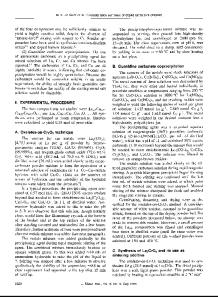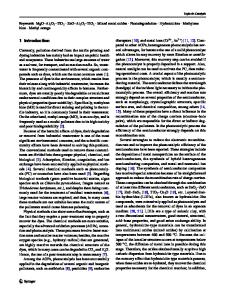Synthesis and Characterization of Ni/Mg/Al Mixed Oxides Obtained by Co-precipitation
- PDF / 644,970 Bytes
- 8 Pages / 432 x 648 pts Page_size
- 55 Downloads / 296 Views
Synthesis and Characterization of Ni/Mg/Al Mixed Oxides Obtained by Co-precipitation G. Martínez-Lozano1, T. Kryshtab1, M. Hesiquio Garduño2 and A. Kryvko3 1
Department of Physics, ESFM, Instituto Politécnico Nacional, U.P.A.L.M., Av. IPN S/n, Edif. 9, C. P. 07738, Mexico D. F., Mexico. 2 Department of Petroleum Chemical Engineering, ESIQIE, Instituto Politécnico Nacional, U.P.A.L.M., Av. IPN S/n, Edif. 8, C. P. 07738, Mexico D.F., Mexico. 3 Department of Systems, ESIME, Instituto Politécnico Nacional, U.P.A.L.M., Av. IPN S/n, Edif. 4, C. P. 07738, Mexico D.F., Mexico. E-mail: [email protected] ABSTRACT Ni/Mg/Al mixed oxides were obtained from hydrotalcite-like precursors by thermal decomposition at 400º, 600º and 800ºC using co-precipitation method at pH 7. The mixed oxides were characterized by X-ray diffraction (XRD), Scanning electron microscopy (SEM), and Energy-dispersive X-ray spectroscopy (EDS) techniques. XRD analysis revealed the formation of NixMg1-xO (x = 0 - 1), D-Al2O3 and traces of MgAl2O4 (NiAl2O4) phases. The diffraction peak positions for MgO or NiO oxides were shifted towards 2ș values higher than simulated for pure bulk oxides that can be attributed to the possible presence of lattice vacancies or surface compressive stress. The evaluated grain size by XRD technique was about 8 -10 nm. It was also detected the presence of microstrains that can be associated with the presence of extended defects in the grains. SEM observations showed that the particles of oxides are formed as agglomerates with the particle sizes of 50 nm up to 200 nm. EDS detected the presence of Mg2+, Ni2+, and Al3+ cations and oxygen in all particles independently on their size. The obtained results revealed the presence of mixture of Ni/Mg/Al oxides in each particle obtained. The oxides calcined at temperatures of 400º and 600ºC were unstable and under air storage they revert to the precursor. The incorporation of Ni2+ in Mg-Al mixed oxides leads to stability of the compounds calcined at 800ºC. Keywords: Hydrotalcite; Mixed oxides; Co-precipitation; X-ray diffraction; Microstructure INTRODUCTION Layered double hydroxides are anionic clay-like compounds or more specifically hydrotalcites-like compounds (HTLCs) [1-3]. They are usually synthesized and their symmetry is rhombohedral or hexagonal, also are less found in nature than cationic clays, but they can easily synthesized in laboratory. These compounds have many industrial applications due to their physicochemical properties, particularly in homogeneous catalysis, either as such or after controlled thermal decompositions. Upon heating, these highly ordered hydrotalcite-like compounds form a mixture of metal oxides, with a very small crystal sizes that are stable under thermal treatment. These mixed oxides show interesting properties, such as high specific surface
13
area, high active metal dispersion, a strong interaction between different metals in mixed oxides, a basic character of the calcined mixed oxides and a better resistance to sintering. Ni/Mg/Al mixed oxides
Data Loading...











